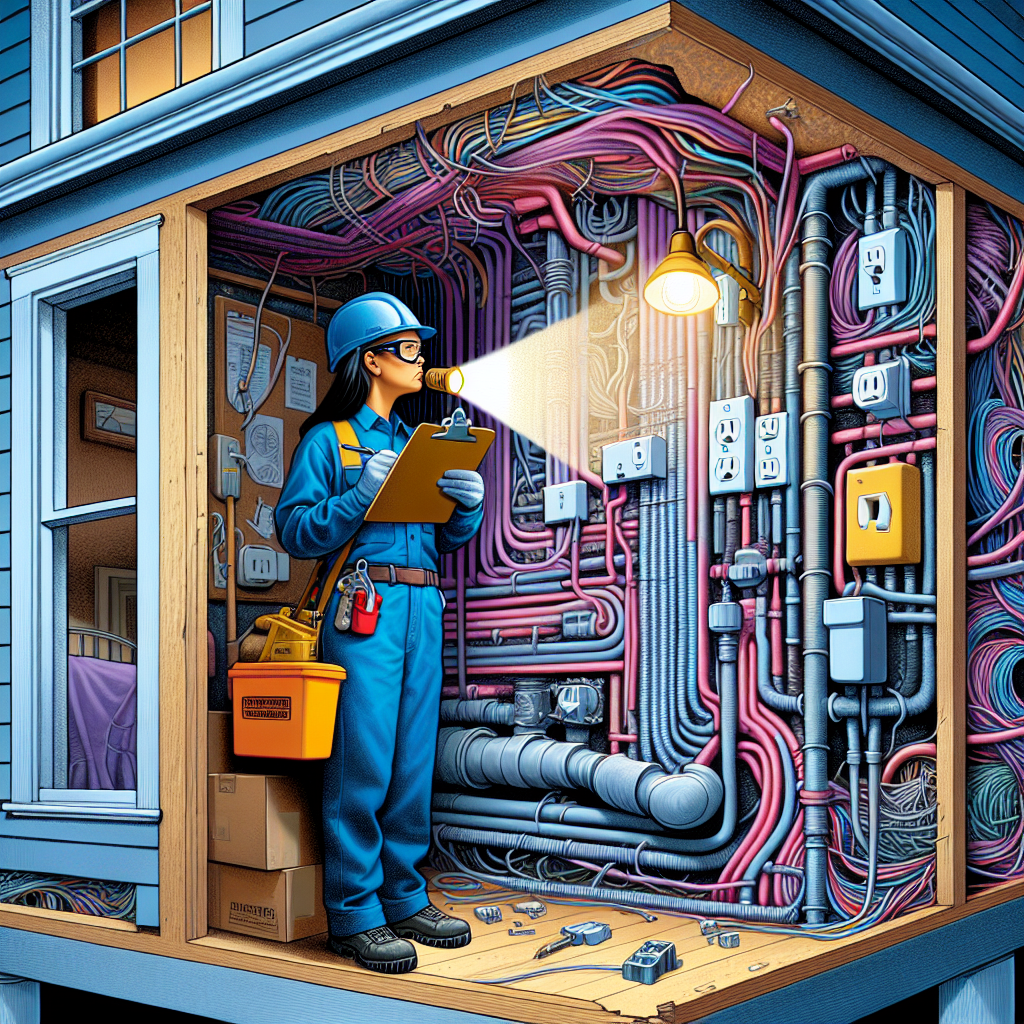Discover the hidden dangers within your walls.
Behind the Walls: A Deep Dive into Home Electrical Inspections is a comprehensive guide that delves into the intricacies of inspecting electrical systems within residential properties. This in-depth examination explores the importance of home electrical inspections, provides valuable insights into potential hazards, and offers practical tips for ensuring safety and compliance. Whether you are a homeowner, real estate professional, or an aspiring electrician, this guide equips you with essential knowledge to identify common issues, understand relevant codes and standards, and make informed decisions regarding your electrical system’s maintenance or purchase.
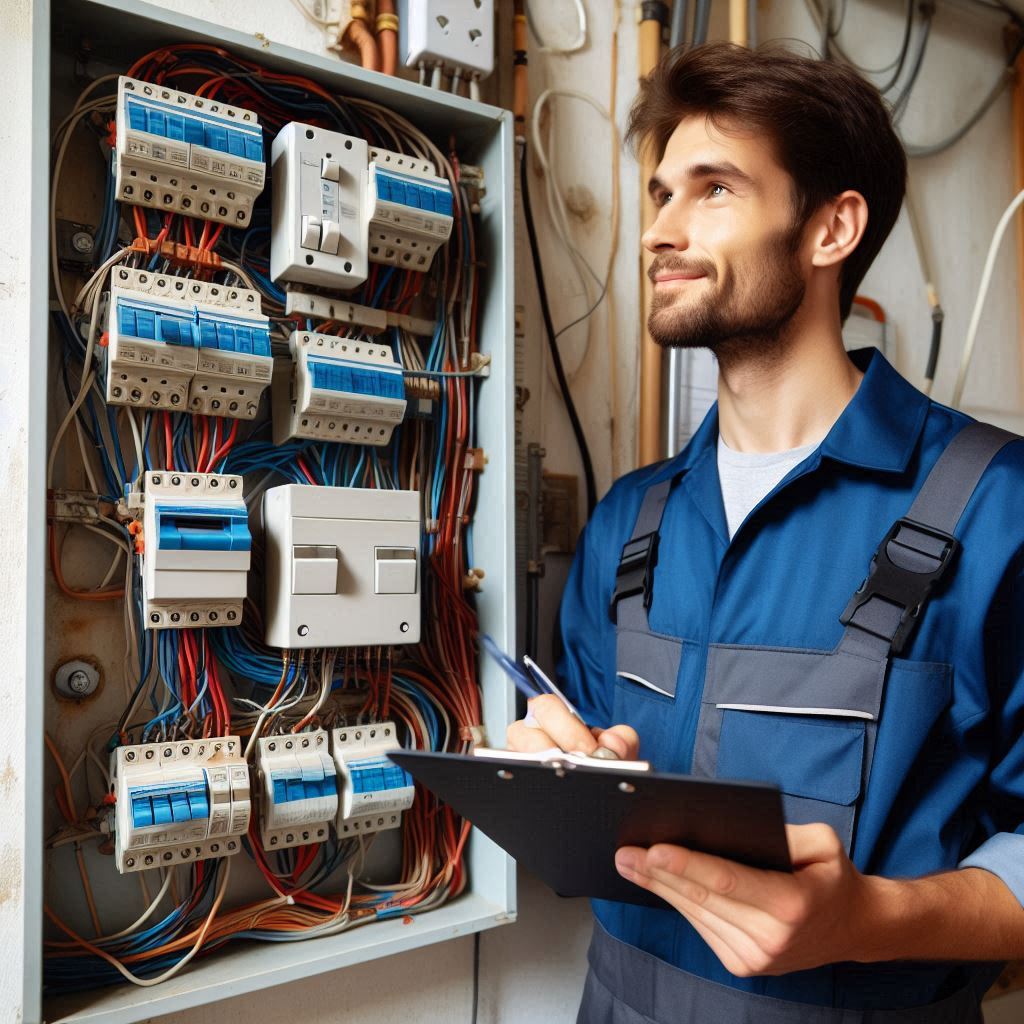
The Importance of Home Electrical Inspections
In today’s modern world, electricity is an essential part of our daily lives. It powers our homes, provides lighting, and enables us to use a multitude of appliances and gadgets. However, it is crucial to ensure that the electrical systems in our homes are safe and up to code. That’s where home electrical inspections come into play.
A home electrical inspection is a comprehensive assessment of a property’s electrical system conducted by a qualified electrician or inspector. These inspections are designed to identify any potential hazards or deficiencies in the wiring, outlets, switches, circuit breakers, and other components that make up the electrical system.
One might wonder why such inspections are necessary. After all, as long as the lights turn on when we flip the switch and there are no noticeable issues with outlets or appliances, everything must be fine – right? Unfortunately, this assumption can lead to complacency when it comes to home safety.
Electrical fires account for thousands of house fires each year. Faulty wiring or outdated electrical systems often contribute to these devastating incidents. Additionally, electrocutions caused by faulty installations or inadequate grounding can result in serious injuries or even death.
This highlights the critical importance of regular home electrical inspections. These inspections help identify potential fire hazards such as loose connections, overloaded circuits, faulty wiring insulation and grounding issues before they become major problems.
Homeowners may also overlook another significant aspect: insurance coverage. Many insurance providers require periodic home electrical inspections as part of their policy agreements. Failure to comply with these requirements could potentially void your insurance coverage if an incident occurs due to an undocumented issue with your electrical system.
Moreover , a thorough inspection goes beyond just identifying immediate risks; it can also uncover hidden dangers that may not be apparent at first glance but have serious consequences over time . For example , outdated knob-and-tube wiring was commonly used in homes built prior to the 1940s. This type of wiring can be extremely hazardous due to its lack of grounding and insulation, making it a significant fire risk.
Additionally, inspections can uncover poorly executed do-it-yourself (DIY) electrical work. While the intention behind DIY projects may be noble, without proper knowledge and experience , these installations or repairs can lead to faulty connections, improper load calculations, or inadequate grounding – all potential safety hazards .
To conduct a home electrical inspection effectively , certified electricians utilize various tools and techniques . They examine the condition of wiring systems throughout the house , including outlets and switches . They also assess breaker panels for correct labeling and operation . Furthermore , inspectors check if GFCI (Ground Fault Circuit Interrupter) outlets are installed in appropriate areas such as bathrooms , kitchens , garages or outdoor spaces .
It is important to note that home electrical inspections should not be limited to older properties. Even newly constructed homes can have hidden issues or mistakes made during installation that only become evident with a thorough examination.
In conclusion, home electrical inspections play an indispensable role in ensuring the safety and well-being of homeowners. By identifying potential hazards and deficiencies within our electrical systems before they escalate into major problems, these inspections protect against fires, electrocutions, property damage, injuries,and even insurance coverage gaps. Remember: when it comes to your home’s electricity – prevention is always better than cure!
Understanding the Basics of Electrical Systems in Homes
Electricity is an essential component of modern living, powering our homes and enabling us to perform a wide range of tasks. However, behind the walls lies a complex network of electrical systems that require regular inspection and maintenance to ensure their safety and efficiency. In this article, we will take a deep dive into home electrical inspections, exploring the basics of electrical systems in homes.
At its core, a home electrical system consists of three main components: the service entrance panel, wiring circuits, and outlets or switches. The service entrance panel serves as the central hub for electricity entering the home from the utility company’s power lines. From there, it distributes power to various circuits throughout the house via wiring.
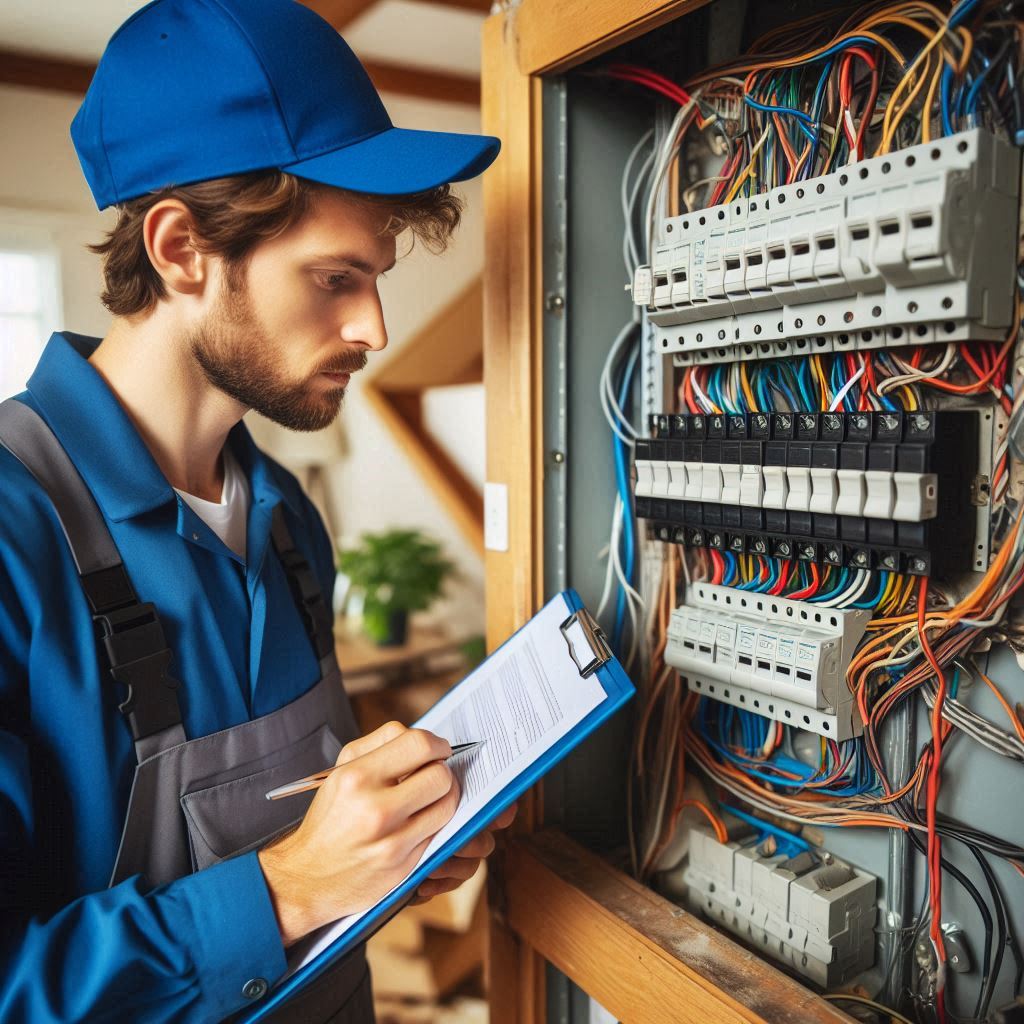
Wiring circuits are responsible for carrying electricity from the service entrance panel to individual outlets and switches throughout your home. These circuits typically consist of three wires: hot wires (black or red), neutral wires (white), and ground wires (green or bare copper). Hot wires carry current from the service panel to devices such as light fixtures or appliances; neutral wires provide a return path for current flow back to the panel, while ground wires serve as safety measures by directing excess electricity into Earth if there is a fault.
Outlets and switches play a crucial role in allowing homeowners access to electricity at various locations within their homes. Outlets provide convenient access points where you can plug in devices like lamps or chargers while switches control whether lights or other electronic equipment are turned on or off.
Now that we have established an understanding of these basic components let us turn our attention towards why regular inspections are necessary for maintaining your home’s electrical system.
Electrical inspections help identify potential hazards that could lead to electric shock or fire hazards within your home. Over time, wear-and-tear on wiring can cause insulation breakdowns or exposed live conductors – both conditions pose significant risks if not promptly addressed by professionals during an inspection.
Furthermore, inspections can detect overloaded circuits or outdated wiring that may not be able to handle the electrical demands of modern appliances. This is particularly important if you are considering remodeling or adding new equipment to your home.
Additionally, inspections ensure compliance with electrical codes and regulations set forth by local authorities. Adhering to these codes helps protect the safety of homeowners and their property, as well as ensuring insurance coverage in case of any unfortunate events related to electricity.
During an inspection, a qualified electrician will thoroughly examine all components of your electrical system, including service panels, circuit breakers, switches, outlets, and wirings. They will check for any signs of damage such as frayed wires or loose connections that could lead to dangerous situations.
In conclusion, understanding the basics of electrical systems in homes is crucial for homeowners looking to maintain a safe living environment. Regular inspections are necessary not only for identifying potential hazards but also for ensuring compliance with relevant codes and regulations. By prioritizing electrical inspections and promptly addressing any issues discovered during these evaluations through professional repairs or upgrades when necessary; homeowners can rest easy knowing they have taken proactive steps towards safeguarding their homes against electric shock and fire hazards associated with faulty wiring or outdated components.
Common Electrical Hazards and How to Identify Them
In order to ensure the safety of your home, it is crucial to be aware of potential electrical hazards that may be lurking behind its walls. Identifying these hazards can help prevent dangerous situations such as electrical fires or electrocution. This article aims to provide a comprehensive overview of common electrical hazards and offer guidance on how to identify them.
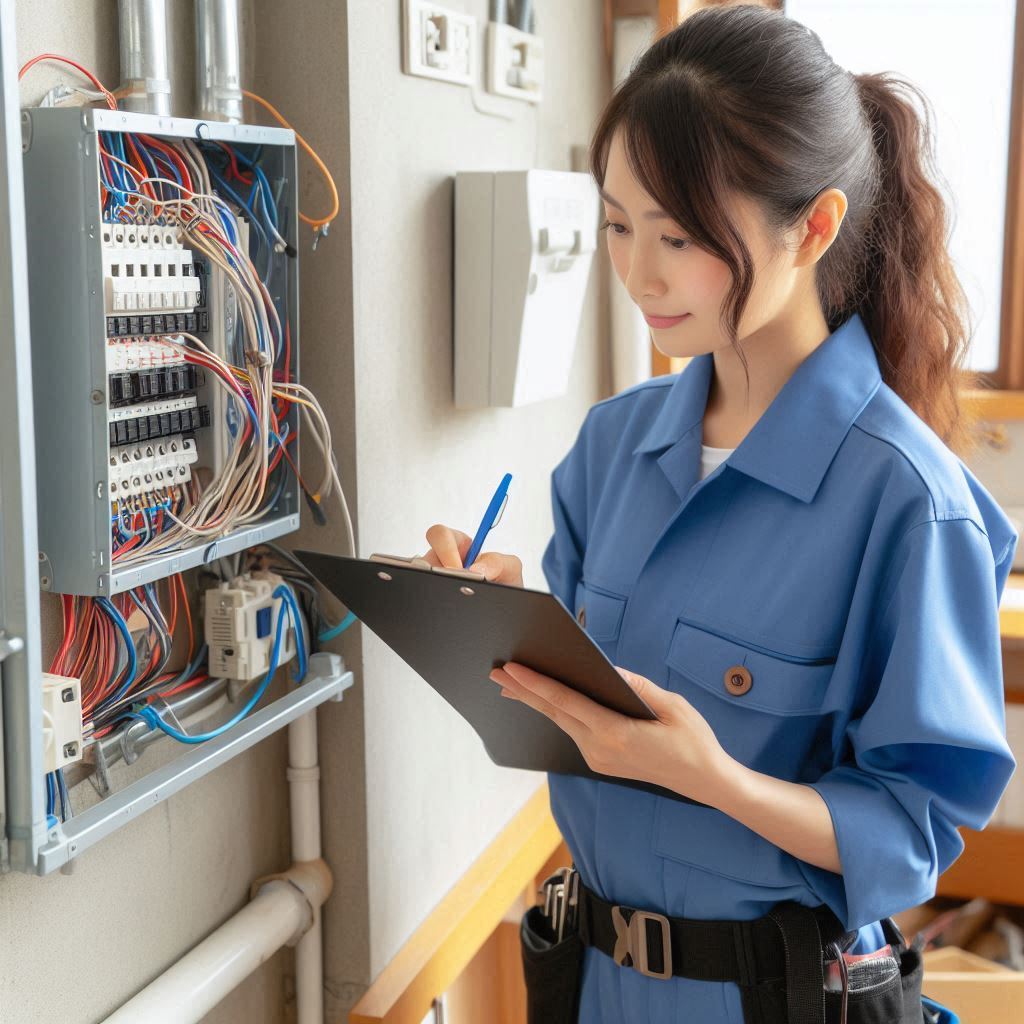
One of the most common electrical hazards is faulty wiring. Over time, wiring can become worn out or damaged due to factors such as age, rodents chewing on wires, or improper installation. Faulty wiring poses a significant risk as it can lead to short circuits and overheating, potentially causing a fire. Signs of faulty wiring include flickering lights, outlets that are warm to the touch, circuit breakers frequently tripping, or discolored power outlets.
Another hazard often encountered in homes is outdated electrical panels. Older homes may still have fuse boxes instead of modern circuit breaker panels. Fuse boxes are more prone to overload and are less effective at protecting against electrical faults. Additionally, older panel boards may not meet current safety standards and cannot handle the electricity demands of modern appliances and devices. To determine if you have an outdated panel board, look for signs such as fuses blowing frequently or having trouble running multiple appliances simultaneously.
Improper grounding is yet another hazardous condition commonly found in homes’ electrical systems. Grounding refers to providing an alternative path for electricity should a fault occur in an appliance or wiring system by connecting them safely with the ground wire in an outlet box connected directly into the earth’s surface through metal water piping systems etc.. Without proper grounding, excess voltage can build up within appliances leading them susceptible to damage during power surges while posing a risk for electrocution when touched by humans who serve as conductors themselves! To detect improper grounding check if there’s no visible ground wire attached securely where it should be- like near light switches or outlets.
Overloaded circuits are a significant concern in households, particularly those with older wiring systems. An overloaded circuit occurs when too many electrical devices are connected to a single circuit, exceeding its capacity. This can cause the wires to overheat and potentially start a fire. Warning signs of an overloaded circuit include frequently tripped breakers or blown fuses, dimming or flickering lights, or appliances not operating at their full power.
It is essential to be vigilant about the presence of exposed electrical wires in your home. Exposed wires pose a severe risk for electrocution as they may come into contact with water, metal objects, or human touch accidentally. Examine areas where there might be hidden wiring such as behind walls, under carpets, and inside junction boxes for any visible signs of frayed insulation or loose connections.
In conclusion, conducting regular inspections to identify common electrical hazards is vital for maintaining the safety of your home and preventing potential accidents such as fires or electric shocks. By paying attention to warning signs like flickering lights, warm outlets, frequent breaker trips, outdated panel boards/fuse boxes damaged insulation on exposed wiring it will allow homeowners an opportunity t stay proactive with repairs before dangerous situations arise! Remember that ensuring proper grounding and avoiding overloading circuits are key steps towards promoting electrical safety within your household!
Step-by-Step Guide to Conducting a Thorough Home Electrical Inspection
When it comes to ensuring the safety and functionality of your home, a thorough electrical inspection is paramount. With faulty wiring and outdated electrical systems posing potential hazards, understanding how to conduct a proper inspection can save you from costly repairs or even dangerous accidents. In this article, we will provide you with a step-by-step guide on how to perform a comprehensive home electrical inspection.
The first step in conducting an effective home electrical inspection is familiarizing yourself with the necessary tools and equipment. Before beginning any work, gather essential items such as a voltage tester, wire strippers, pliers, screwdrivers of various sizes, circuit breaker finders, and outlet testers. These tools will assist you in identifying potential issues that may exist within your electrical system.
Once equipped with the necessary tools for the job, start by turning off all power sources in your home. This precautionary measure ensures your safety while examining outlets and fixtures. Begin inspecting each outlet individually by using an outlet tester or voltage tester to determine if there are any live wires present or if there are any irregularities in the current flow.
As you move throughout your house checking outlets for functionality and grounding issues, pay close attention to any signs of wear or damage on switches and receptacles. Additionally look out for loose connections or exposed wires which could pose serious risks including electric shocks or fires.
After completing the initial examination of outlets and switches within each room’s walls – both inside rooms like living areas as well as those on external walls such as kitchens – proceed to inspect light fixtures thoroughly. Remove bulbs carefully before checking connections inside sockets; ensure no frayed wires are visible before reinstalling new bulbs securely.
Next up on our checklist are circuit breakers located either within fuse boxes or breaker panels throughout your residence—often found near entrances like hallways for easy access during emergencies when power needs quick disconnection (and subsequent reconnection after resolving issues). Make sure all breakers are properly labeled, matching the corresponding circuits they control.
Moving on from circuit breakers, take a closer look at your home’s wiring system. Pay attention to any exposed wires or those in contact with water sources such as pipes and faucets. Check for signs of overheating or melting insulation which could indicate electrical overload or faulty installation practices.
Furthermore, examine the grounding system present in your home. This safety feature helps divert excess electrical current to prevent shocks and fires by providing a path of least resistance for electricity should an abnormal event occur. Ensure that all outlets and switches are grounded correctly using an outlet tester; also verify if metal components like plumbing fixtures are appropriately connected to the ground.
Lastly, inspect outdoor areas where electrical components may exist such as garage outlets, garden lighting systems, or exterior power sources. These areas can often be overlooked but should not be neglected due to their exposure to various weather conditions that may impact functionality over time.
In conclusion, conducting a thorough home electrical inspection is vital for maintaining the safety and functionality of your residence. By following this step-by-step guide along with utilizing the necessary tools and equipment, you can identify potential hazards before they become major problems—saving you time, money, and ensuring peace of mind for years to come. Remember always prioritize safety when working with electricity by turning off power sources before examining outlets or fixtures thoroughly.
Signs That Your Home Needs an Electrical Upgrade or Repair
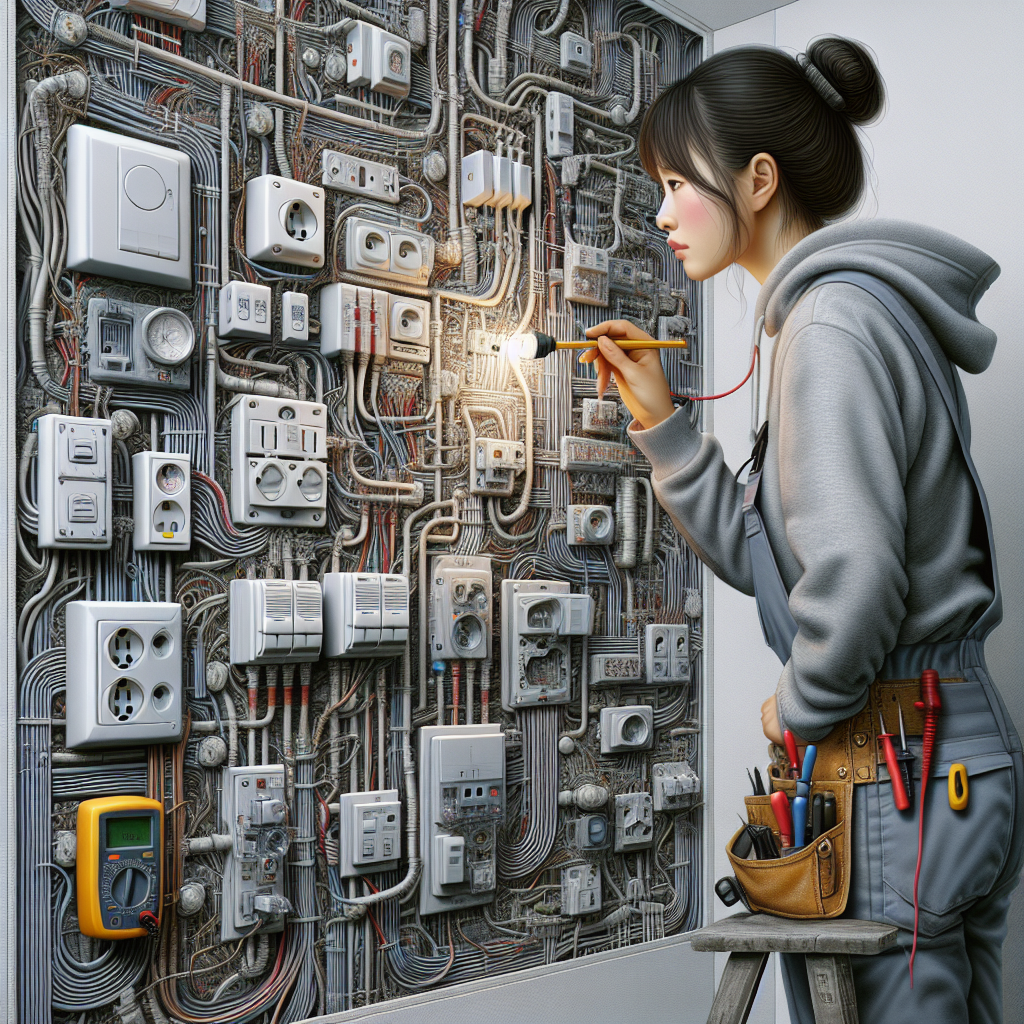
Home electrical systems play a vital role in our everyday lives, providing power to appliances and devices that we rely on for convenience, comfort, and even safety. However, just like any other system in our homes, the electrical system can deteriorate over time due to wear and tear or improper maintenance. It is crucial for homeowners to be aware of signs indicating that their home needs an electrical upgrade or repair.
One common sign that your home may need an electrical upgrade is if you frequently experience circuit breaker trips. Circuit breakers are designed to protect your home from electrical overloads by shutting off power when it detects excessive current flow. However, if you notice that your circuit breaker frequently trips even when there is no apparent reason for it, this could indicate underlying issues with the wiring or other components of your electrical system.
Another sign that suggests the need for an electrical upgrade is if you have outlets and switches that are warm to the touch. While some warmth is normal during use, excessive heat can be a sign of loose connections or overloaded circuits. Warmth can also indicate faulty wiring behind walls which poses serious fire hazards.
If you notice flickering lights in your home regularly, this could be another indication of potential problems with your electrical system. Flickering lights may occur due to loose connections or outdated wiring unable to handle the load required by modern-day electronics and appliances. Ignoring such signs could lead to further damage and potentially dangerous situations.
Older homes often lack sufficient grounding systems which ensure safe distribution of electricity throughout the house. If you reside in an older property without grounded outlets (typically three-pronged), this signals a need for immediate attention as ungrounded systems increase the risk of electric shock incidents significantly.
Outdated panels are another red flag pointing towards necessary upgrades or repairs within your home’s electrical infrastructure. Older panel boxes typically offer lower amp capacities than what most households require today, resulting in overloading and safety concerns. Additionally, these outdated panels often lack proper circuit breakers or protection devices that newer systems possess.
In some cases, you may notice a burning smell coming from outlets or switches. This odor is a clear indication of electrical overheating which can lead to devastating consequences such as fires. If you encounter this alarming sign, it is crucial to act promptly and seek professional assistance.
Lastly, frequent power surges in your home can indicate problems with the electrical system that need attention. Power surges occur when there are sudden increases in voltage flowing through the wiring network. While minor surges are normal and can be caused by external factors such as lightning strikes or utility company issues, repeated power surges could be a result of faulty wiring or improper grounding.
In conclusion, being aware of signs indicating that your home needs an electrical upgrade or repair is essential for maintaining a safe living environment for you and your family. Signs such as frequent circuit breaker trips, warm outlets and switches, flickering lights, lack of grounding systems in older homes, outdated panels with limited capacity or protection devices, burning smells from outlets or switches, and frequent power surges all warrant immediate attention from qualified professionals who can identify and resolve these issues before they escalate into major safety hazards
Frequently Asked Questions About Home Electrical Inspections Answered
When it comes to the safety and functionality of your home, there is nothing more crucial than ensuring that your electrical system is up to code. Electrical inspections are an integral part of maintaining a safe living environment, but many homeowners may have questions about what these inspections entail and why they are necessary. In this article, we will dive deep into frequently asked questions about home electrical inspections.
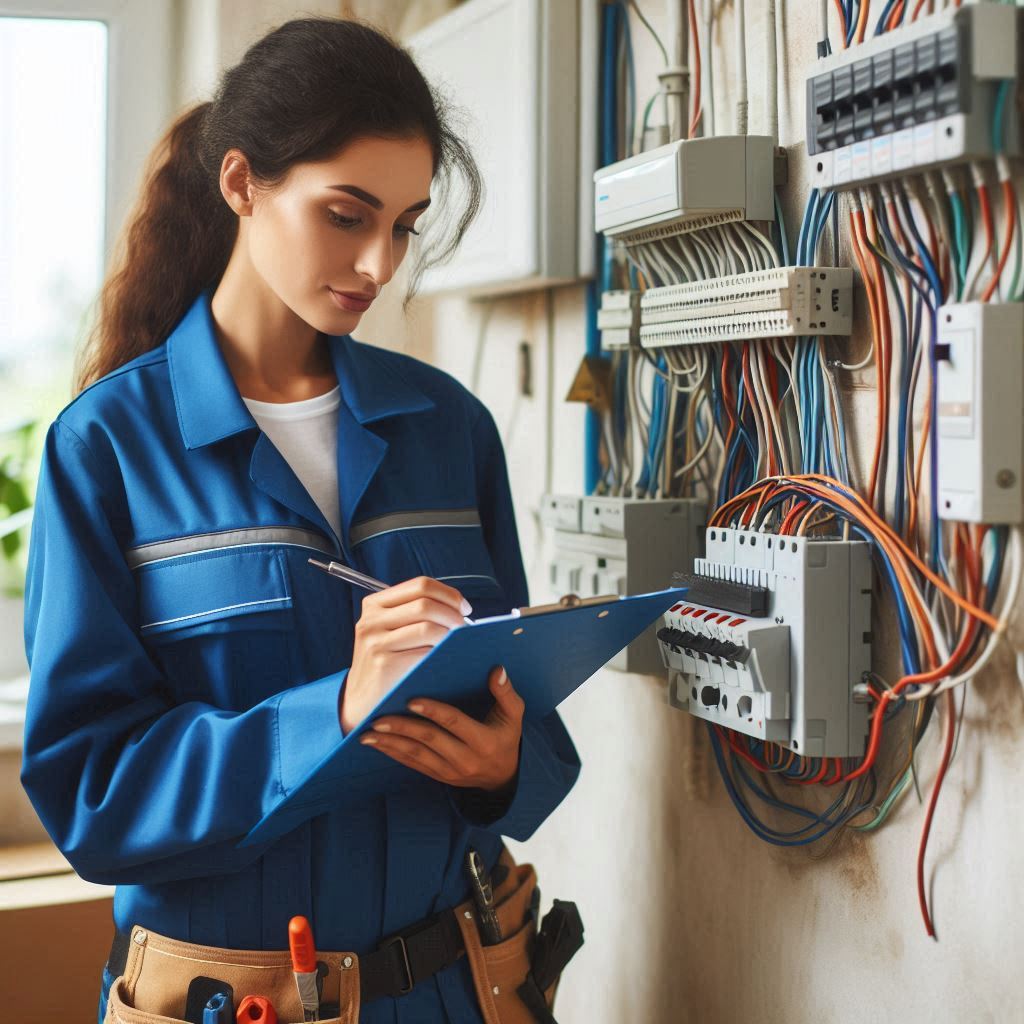
What is a home electrical inspection?
A home electrical inspection is a thorough examination of your property’s electrical system to assess its compliance with safety standards and regulations. Qualified electricians conduct these inspections by examining wiring systems, outlets, switches, circuit breakers, grounding equipment, and other components that make up the overall electrical infrastructure of your home.
Why should I get a home electrical inspection?
The primary reason for getting a home electrical inspection is to ensure the safety of yourself and your family. Faulty or outdated wiring can lead to dangerous situations such as electrocution or fire hazards. By identifying potential problems early on through an inspection, you can take corrective measures before accidents occur.
Additionally, having an updated and properly functioning electrical system increases the efficiency of electricity usage in your household. This not only saves you money on utility bills but also reduces unnecessary strain on appliances and electronics.
When should I schedule a home electrical inspection?
There are several instances when scheduling a home electrical inspection becomes necessary. If you live in an older house with outdated wiring or have recently purchased a pre-owned property, it is advisable to have an immediate assessment done by professionals.
Furthermore, if you experience recurring issues such as flickering lights or frequent tripping circuit breakers, these could be signs of underlying problems that require attention from an expert electrician.
How long does a typical home electrical inspection take?
The duration of a home electrical inspection depends on various factors such as the size of your property and its current condition. Generally speaking, a thorough inspection can take anywhere from two to four hours. However, more extensive evaluations may be necessary for larger or older homes with intricate electrical systems.
What will the electrician look for during an inspection?
During an electrical inspection, the electrician will examine multiple aspects of your home’s electrical system. They will assess the condition and capacity of your wiring, check for proper grounding and bonding, inspect the functionality of outlets and switches, test circuit breakers for efficiency, evaluate lighting fixtures for safety measures such as appropriate bulb wattage and placement distance from flammable materials.
Additionally, they may also conduct load testing to determine if your electrical system is capable of handling the demand placed on it by appliances and devices used in your home.
In conclusion, home electrical inspections are crucial in maintaining a safe living environment. By getting these inspections done at regular intervals or when specific issues arise, you can ensure that your property’s electrical system meets safety standards while preventing potential hazards. Remember to hire qualified professionals to perform these inspections so that you receive accurate assessments and recommendations based on their expertise.
Tips for Hiring a Professional Electrician for Your Home Inspection Needs
When it comes to ensuring the safety and functionality of your home, few things are as important as a thorough electrical inspection. Electrical systems play a vital role in our daily lives, providing power for lighting, appliances, and other essential functions. However, these systems can deteriorate over time or become damaged due to various factors such as aging infrastructure or faulty installation. This is why hiring a professional electrician for your home inspection needs is crucial.
First and foremost, it is essential to understand what an electrical inspection entails. During an electrical inspection, a qualified electrician will assess the condition of your home’s wiring system. They will carefully examine both visible components, such as outlets and switches, as well as hidden elements behind walls or within crawl spaces.
One key reason why you should hire a professional electrician for this task is their expertise and experience. These professionals possess in-depth knowledge about electrical systems that allows them to identify potential issues that an untrained eye might miss. Moreover, they have practical experience working with diverse types of properties and varying electrical installations.
Hiring a professional also ensures compliance with safety regulations and codes put forth by local authorities. Electricians keep themselves updated on any changes made in these regulations so that they can ensure adherence during inspections. Non-compliance could not only jeopardize your family’s safety but may also result in penalties or complications when selling your property.
Furthermore, another advantage of hiring an experienced electrician lies in their ability to detect underlying problems through advanced diagnostic techniques like thermal imaging or voltage testing. By utilizing such tools alongside their extensive knowledge base, these experts can identify issues that would otherwise remain unnoticed until causing significant damage.
Another aspect worth considering when selecting an electrician for your home inspection needs is their reputation within the industry. It is always advisable to seek recommendations from trusted sources such as friends or family who have had positive experiences with specific professionals. Additionally, online reviews and testimonials can offer insights into the quality of service provided by different electricians.
Additionally, communication is crucial when hiring an electrician for your home inspection. A professional should be able to clearly explain their findings and recommend any necessary repairs or improvements. This transparency ensures that you are fully informed about the condition of your electrical system and allows you to make informed decisions regarding any required maintenance.
Lastly, it is essential to inquire about insurance coverage before hiring an electrician. Accidents or damages can occur during inspections, so ensuring that the professional has liability insurance protects both parties involved.
In conclusion, a thorough electrical inspection is vital for maintaining a safe and functional home. Hiring a professional electrician brings expertise, experience with safety regulations, advanced diagnostic techniques, industry reputation, effective communication skills, and insurance coverage—all of which contribute to a successful inspection process. By prioritizing these factors when selecting an electrician for your home inspection needs, you can ensure peace of mind knowing that your property’s electrical system is in capable hands.
Exploring Different Types of Wiring and their Safety Implications
When it comes to home electrical inspections, one important aspect that must be thoroughly examined is the type of wiring used in a house. The choice of wiring can have significant safety implications for homeowners and occupants. In this section, we will delve into different types of wiring commonly found in residential properties and discuss their respective advantages and potential hazards.
Firstly, let us consider knob-and-tube (K&T) wiring. This type of wiring was commonly installed in homes built between the 1880s and the 1940s. K&T wiring consists of ceramic knobs that hold wires away from wood framing members and porcelain tubes that protect wires as they pass through holes drilled in wooden joists or studs. While K&T wiring may still function effectively if properly maintained, it poses several safety concerns due to its age and design.
One primary issue with K&T wiring is insulation deterioration over time. The insulation materials used back then were often made from organic substances like cloth or rubber which deteriorate more rapidly than modern synthetic materials such as PVC or Teflon. Consequently, exposed or degraded wires are at risk of overheating, leading to electrical fires.
Another concern with K&T wiring is its lack of grounding capability. Grounding provides an essential path for electrical faults to safely dissipate energy into the ground rather than posing risks within a home’s electrical system. Without proper grounding, there is an increased chance of electric shock when interacting with appliances or switches.
Moving on from K&T wiring, another common type found in older houses is aluminum branch circuit (ABC) wire. ABC wire gained popularity during the 1960s and early 1970s due to rising copper prices; however, its use has since diminished due to safety concerns associated with aluminum connections.
One major hazard associated with ABC wire lies in improper connections causing overheating issues at termination points such as outlets or switches. Aluminum wire expands and contracts more than copper, potentially leading to loose connections over time. Loose connections can generate excessive heat, posing a fire hazard.
Additionally, aluminum wiring is prone to oxidation when exposed to air, which further increases the risk of overheating at connection points. Therefore, it is crucial for homeowners with ABC wire in their homes to have regular inspections and maintenance performed by qualified electricians.
Lastly, let us consider modern wiring options such as non-metallic sheathed cable (NM) or armored cable (AC). NM cables are commonly known as Romex® and consist of multiple conductors surrounded by plastic insulation. AC cables, on the other hand, have metal armor protecting the conductors. Both types provide excellent safety features compared to older wiring alternatives.
One advantage of NM or AC cables is their ability to withstand higher temperatures without degradation. Modern synthetic insulating materials used in these cables are designed to be more heat-resistant than those found in K&T or ABC wiring systems.
Furthermore, both NM and AC cables offer grounding capability through an additional conductor dedicated solely for this purpose. This grounded conductor significantly reduces the risk of electric shock when properly connected and maintained according to electrical codes.
In conclusion, understanding different types of wiring commonly found in residential properties allows homeowners and inspectors alike to identify potential safety hazards associated with each type. While K&T and ABC wires pose significant risks due to age-related deterioration or improper connections respectively, modern options like NM or AC cables offer superior safety features such as increased insulation quality and reliable grounding capabilities. Regular inspections conducted by qualified professionals remain essential for ensuring a safe electrical system within homes today.
Maintaining Safe and Reliable Electricity in Your Home: Best Practices
When it comes to ensuring the safety and reliability of your home’s electrical system, regular inspections are crucial. By going beyond what meets the eye, a thorough examination can identify potential issues that might otherwise go unnoticed. In this article, we will take a deep dive into home electrical inspections, exploring why they are important and what best practices should be followed.
To understand the significance of home electrical inspections, one must first recognize that faulty or outdated wiring is one of the leading causes of residential fires. These fires not only pose a threat to human life but also result in significant property damage. Therefore, conducting routine inspections helps mitigate these risks by identifying any wiring problems before they escalate.
A comprehensive inspection should include an assessment of various aspects related to your home’s electrical system. This includes examining the main service panel and all subpanels for signs of wear and tear or overheating. Loose connections or corroded wires could indicate underlying issues that require immediate attention.
Furthermore, inspecting outlets throughout your home is equally essential. The inspector will ensure proper grounding while testing each outlet for functionality. Additionally, they may check for GFCI (Ground Fault Circuit Interrupter) outlets in areas such as kitchens, bathrooms, laundry rooms, and outdoor spaces – places where water increases the risk of electric shock.
Another critical area to focus on during an inspection is your home’s lighting fixtures. An experienced inspector will assess both indoor and outdoor lighting systems for any visible signs of wear or damage that could compromise their safety or function.
Aside from visible components like panels and outlets, inspectors will also investigate behind-the-wall infrastructure such as conduits and junction boxes. These concealed elements play a vital role in routing electricity safely throughout your home but can deteriorate over time due to pests or environmental factors like moisture intrusion.
In addition to evaluating existing components, inspectors will also assess the overall electrical load of your home. This involves reviewing the capacity and adequacy of your current electrical service in relation to your energy consumption needs. In some cases, an upgrade may be recommended to prevent overload situations that could lead to system failures or even fires.
To ensure a comprehensive inspection, it is important to hire a licensed and certified electrician with expertise in conducting thorough examinations. They should possess extensive knowledge of local building codes and regulations specific to electrical systems.
After completing the inspection, you will receive a detailed report outlining any identified issues or potential hazards. It is crucial to review this report carefully and address any necessary repairs promptly. Ignoring these recommendations could not only compromise safety but also result in more significant repair costs down the line.
In conclusion, home electrical inspections are essential for maintaining safe and reliable electricity within your living space. By delving behind the walls and thoroughly examining all aspects of your electrical system – from panels and outlets to hidden infrastructure – potential problems can be identified early on, reducing the risk of fire hazards or equipment failure. Remember that prevention is key when it comes to protecting both lives and property from electrical accidents – so prioritize regular inspections as part of your best practices for maintaining a safe home environment.In conclusion, “Behind the Walls: A Deep Dive into Home Electrical Inspections” is a comprehensive and informative resource that delves into the various aspects of inspecting home electrical systems. It provides valuable insights on safety measures, common issues, and necessary repairs or upgrades to ensure optimal functionality. This deep dive offers homeowners, inspectors, and professionals in the field a thorough understanding of home electrical inspections and their importance in maintaining a safe living environment.
